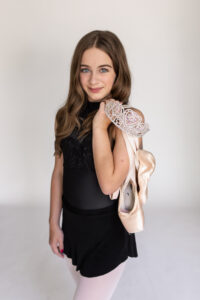
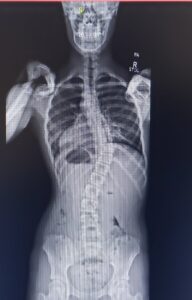
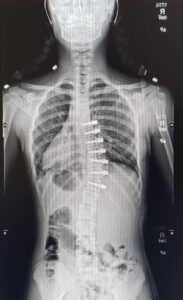
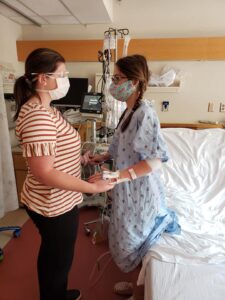
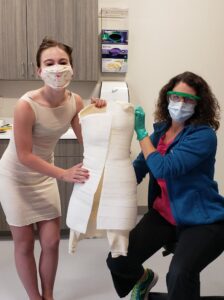
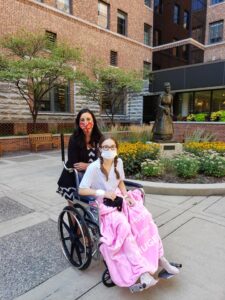
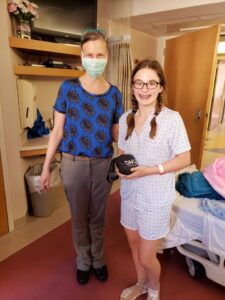
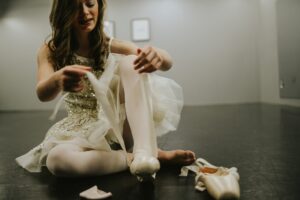
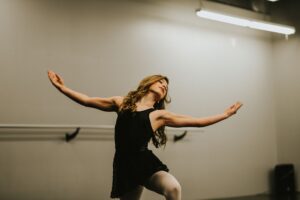
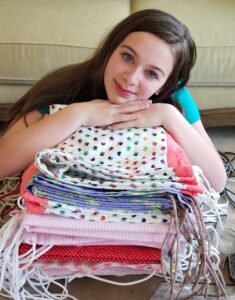
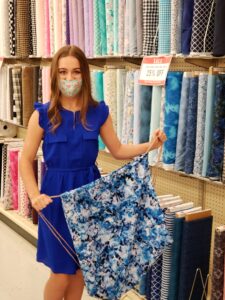
Hi! My name is Alexis Thompson. I am 13 years old and live in North Dakota. I love dance, art, Broadway, helping others, and hanging out with my friends.
In March of 2018, while having a dress altered, my seamstress noticed that my shoulders were uneven. Shortly after that, my parents took me to a free screening clinic from Shriners Children’s where I had x-rays done on my back. Doctors found three curves – one in my neck and two in my spine. I was diagnosed with Adolescent Idiopathic Scoliosis and immediately was sent to Shriners Children’s in a larger city, about 7 hours away from where I live. Then, doctors fit me for my first back brace which I had to wear 20 hours every day to hopefully stop the progression of the curvature of my spine. They also gave me extensive physical therapy exercises (scoliosis specific exercises – SSE – or the Schroth method) to do at home each day. At first, wearing the brace was NOT fun! It is very restrictive, and as someone who just wants to move, dance and do acrobatics all the time, it was pretty difficult to get used to. I was also kind of nervous that it would look weird with my clothes.
When I was first diagnosed, I was really scared. I didn’t know what having three curves in my neck and spine would mean for my future. Ever since the age of three, I have been a dancer, and it is my absolute favorite thing to do. I have friends who are dancers with scoliosis that were able to continue dancing, but every patient is different and I didn’t know what this life-changing diagnosis would mean for me. Luckily, I was able to continue dancing – doctors told me that it was fine. Exercise is important, and dancing keeps my body strong and flexible. Even so, every time I visited the clinic I spoke to physical therapists, doctors, orthotists (almost everyone I worked with while there) and asked them if it was okay to keep dancing; they always said it was. I wanted to ensure that dancing wasn’t making my back worse.
I wore my brace very diligently for one month and had to go back to the clinic for a follow-up appointment so that my doctors could make sure everything was working. In just one month’s time, my spine had progressed 10 degrees! My doctor told me that it was one of the fastest-progressing case of scoliosis he had ever seen. At that point, everyone was confused and worried. I had to get a full-spine MRI to rule out any other underlying causes that may have explained this big jump. Luckily, everything showed up normal on the MRI. I was sent home with some modified physical therapy exercises for my curve and was being closely monitored.
I didn’t experience another jump like that for almost two years. Every day I wore my brace 20 hours (the time off was spent dancing) to hopefully avoid progression. I learned how to deal with my brace and my spine was staying stable. I realized what I was trying to steer away from – major spine surgery – and that almost scared me into wearing the brace. I didn’t want surgery, because all I wanted to do was keep dancing and maintain flexibility in order to do so. I had no pain with my scoliosis at all until shortly after my February 2020 doctor’s appointment. I was supposed to go to the clinic in May 2020 for a regular visit/checkup, but by then, the Coronavirus pandemic was a major problem so we postponed the appointment. My spine had been stable for two years, I hadn’t changed anything – I was still doing PT and bracing – and so we figured it would be okay to wait another month. But when we went to the appointment rescheduled for the end of June, we realized that my spine curvature had jumped yet again. No wonder my back had started hurting; another 10 degree jump meant my curve measured 45 degrees.
At that point, we knew that surgery was something we needed to look into. My back was giving me a lot of problems and I just wanted it to be fixed. I’d had appointments with a surgeon who did the VBT (Vertebral Body Tethering) surgery before when my spine was holding stable, and we really didn’t think that it was something we would actually have to do. VBT is a newer surgery where a tether is weaved through the spine and pulled taut. It provides full range of motion for the patient once they are fully recovered. I had been trying to avoid the spinal fusion, which doesn’t provide a lot of mobility in the spine and has a long recovery process. The VBT surgery is much less invasive than the fusion. But, VBT has a very limited window of opportunity for the surgery to take place in. At that point, I was almost out of that window. My family had a very difficult decision to make, and we had to do it fast.
Two weeks after the June 2020 appointment, I went back to the clinic to be fit for a new brace. My old one was breaking and not fitting as properly as it should. We talked to many different people during that appointment and asked them all what they would suggest we do. We ultimately decided VBT surgery was in our best interest. It was the best option for me as a dancer, but that didn’t make it any less scary. My surgeon and her team helped push me forward so that I could get my surgery before it was too late. On August 13, 2020, just two weeks after we made the decision, I had VBT surgery. Hospital stays are never fun, but that being said, I think that I was very lucky with having a short hospital stay and recovery time. I was blessed with a great pain management team that helped me feel good throughout my stay. The first week or so was certainly the hardest (although I don’t remember much from the hospital) but they let me go home after about a week, and by the end of that time I was up and walking, climbing stairs, and feeling pretty good. My strength that comes from dancing was very beneficial in the hospital and helped me leave faster than other patients. I was then able to continue the recovery process at home.
At just six weeks post-op, I was told by my surgeon that I could go back to dance and start off with some really light barre work! I chose not to go back right away, just to give my body more time to heal, (and with the pandemic not a lot was going on anyway) so I decided not to push it even though I felt just like normal again. At twelve weeks post-op I was officially recovered and was told I could go back to regular activities.
I had surgery August 13, 2020, and I have had no pain since surgery. I actually feel much better than before surgery because before surgery my back hurt. Now the pain is non-existent. This is different for everyone, but from my understanding, most VBT patients go on to live very normal lives even shortly after surgery! Looking back on it now, I realize that even though it was hard, we made the right decision. My scars are hardly even noticeable! I only have five scars and they are super tiny.
I have learned at a young age that I can find the good in any situation, but I’m not perfect. There were days when I didn’t want to put on my brace. Sometimes I was crabby because a favorite shirt didn’t look good with the brace, or my back hurt because of my brace rubbing/pushing on it. I remember feeling frustrated because I just wanted to run around like other kids and couldn’t do that without taking the brace off and therefore using up the hours I could be out of it. Recovering from surgery wasn’t easy either. I watched my friends dance in our studio’s production of The Nutcracker in December and couldn’t help but wish I was dancing with them. That is ok! Everyone will have days like that because we are human and things are never perfect. But, we can still do things to make ourselves feel better and experience happiness through the tough times. The best piece of advice I can give to anyone who is either having surgery, dealing with a brace, or just going through a tough time is to maintain as positive an attitude you can. That was very helpful in my recovery and I believe helped me to get out of the hospital faster. If you keep reminding yourself that you can do this, you totally can!!! I can honestly say that in my case, the anticipation leading up to surgery was worse than the surgery itself.
One lesson I have learned through my scoliosis diagnosis as well as other things that may not go quite as planned in life, is to find happiness in who you are and in the circumstances that surround you. Maintaining a positive outlook, even during difficult times, can get you through any situation! If my story has taught you anything at all, I hope that it is this: You can find happiness and joy in any situation, even when it is difficult. And it is ok to be frustrated sometimes – just don’t dwell on it for too long. Always choose happiness. Happiness is a choice. When given a situation like this, I could have had a really bad attitude and hoped that people would feel sorry for me, but I really didn’t want to do that. What purpose would that serve? It wouldn’t make my back be straight, and I would just wind up feeling bad. So, I had to find the positives in my situation. First of all, I am still able to dance, even through bracing and surgery, which really makes me happy and proud. I also like road trips, and because my doctor is 7 hours away, I get many of those! Finally, I have found ways to help others through my diagnosis, which is very rewarding and makes me feel good.
I have used my scoliosis journey to hopefully make a difference through my own organization, EmBrace You. I created EmBrace You to advocate for scoliosis patients, provide peer to peer support, and my favorite part – which is getting to create and distribute Brace Bags to scoliosis patients for brace transportation. It can be difficult to find large, sturdy bags for the cumbersome back braces. EmBrace You provides stylish bags called Brace Bags which are given to patients when they receive their back brace from their physician. EmBrace You currently partners with Shriners Children’s, and it is my goal to get Brace Bags distributed nationwide.
I also hold an ongoing toy drive which benefits Shriners Children’s. In 2018, when I first started going to Shriners, I was given a toy after tests and procedures that were uncomfortable or even a little bit scary. I realized that there weren’t many toys for older kids, so I held a toy drive specifically for the older children at the clinic. In a two-week time frame, I collected 200 toys and over $800 in cash donations. Now, each time I go to Shriners I take a new shipment of toys with me. My toy drives have helped over 550 patients and I’ve raised over $2,000. This project makes the patients at Shriners happy and it also saves the clinic money, as it is a non-profit organization. Being older doesn’t make procedures any easier, so being able to provide comfort for patients of all ages makes me feel good!
Raising awareness about scoliosis is also very important to me. In June of 2019 (June is scoliosis awareness month), I started an annual scoliosis awareness campaign – sharing my story and encouraging other scoliosis patients to share theirs. I worked with local media and doctors to provide free scoliosis screenings. In June 2020, I held a scoliosis awareness walk around the ND State Capitol.
I give a 30-minute presentation about EmBrace You, my scoliosis journey, and how to choose happiness despite the circumstance. I enjoy educating people about a topic I am passionate about. I speak to different businesses, schools, and civic organizations. I teach kids how to be accepting of others – especially those who may be “different”. When I speak to adults, I talk about the importance of early detection of scoliosis so they can screen their loved ones. Where I live, scoliosis screenings are no longer done in schools, and all too often, kids go undiagnosed. It is my mission to ensure scoliosis screenings are being done in all schools and in all physician visits. My favorite public speaking event was being able to speak for the national board of directors for Shriners Children’s.
When I was first diagnosed, I didn’t know any girls like me. Noticing a gap that needed to be filled, I found a support group called Curvy Girls and reached out to the national director. I learned that there was not a Curvy Girls chapter in my state and brought the first Curvy Girls chapter to North Dakota and took on the role as the leader. When you are given your first back brace, you are told that you need to wear it 20 hours a day (it depends on the patient) but are usually given no instruction as to how to talk about it with your peers, what shirts look best over the brace, and other normal things that teenagers think about. My group gets together every month. I plan fun activities for us to do like bowling, yoga classes specifically for scoliosis patients, we held an awareness walk, and also meet virtually on Zoom. My favorite part about leading this group is meeting and connecting with the girls. I love when we share tips and tricks and can give each other advice and support. There are people out there who are going through similar things that you are, and when you bring them together, amazing things happen. For more information on Curvy Girls, visit https://www.curvygirlsscoliosis.com/nd.
So, embrace challenges, because through every difficulty comes strength! Scoliosis is a lifelong journey and makes you stronger than you will ever know. Going through this journey can be difficult and frustrating, I know because I’ve been there, but don’t forget to find the positives in your diagnosis. Always EmBrace You and your scoliosis journey!
Follow my journey on social media at:
Facebook: AlexisThompsonChooseHappinessEmBraceYou
Instagram: AlexisThompsonEmBraceYou
Email me at Info.EmBraceYou@gmail.com
Read more patient stories like this from around the world.





